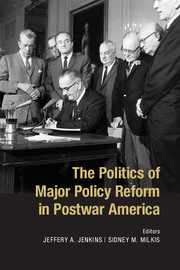Book contents
- Frontmatter
- Contents
- Contributors
- Acknowledgments
- 1 Introduction
- 2 The Long 1950s as a Policy Era
- 3 Regulation, Litigation, and Reform
- 4 Courts and Agencies in the American Civil Rights State
- 5 The Politics of Labor Policy Reform
- 6 Teachers Unions and American Education Reform
- 7 Progressive Federalism and the Contested Implementation of Obama’s Health Reform
- 8 Federalism and the Politics of Immigration Reform
- 9 Trade Politics and Reform
- 10 The Politics of Intelligence Reform
- 11 Follow the Leader
- 12 Conclusion: Madison Upside Down
- Index
- References
4 - Courts and Agencies in the American Civil Rights State
Published online by Cambridge University Press: 05 November 2014
- Frontmatter
- Contents
- Contributors
- Acknowledgments
- 1 Introduction
- 2 The Long 1950s as a Policy Era
- 3 Regulation, Litigation, and Reform
- 4 Courts and Agencies in the American Civil Rights State
- 5 The Politics of Labor Policy Reform
- 6 Teachers Unions and American Education Reform
- 7 Progressive Federalism and the Contested Implementation of Obama’s Health Reform
- 8 Federalism and the Politics of Immigration Reform
- 9 Trade Politics and Reform
- 10 The Politics of Intelligence Reform
- 11 Follow the Leader
- 12 Conclusion: Madison Upside Down
- Index
- References
Summary
Major policy change almost always has multiple causes and generates a variety of far-reaching consequences, some intended, many not. This was certainly true of the civil rights revolution of the 1960s that culminated in passage of two of the most important laws in American history, the Civil Rights Act of 1964 (CRA) and the Voting Rights Act (VRA) of 1965. The resulting destruction of the racial caste system in the South not only profoundly affected the position of African Americans within American society, but created a new party system in which the solid Democratic South became solidly Republican. Prohibitions against racial discrimination were quickly extended to ban discrimination based on gender, language, disability, and age. The civil rights revolution changed our understanding of federalism, the proper role of the courts, the powers of Congress, and the authority of administrative agencies. In short, this was a profound constitutional moment that rivaled that of the New Deal.
In this chapter I cannot hope to describe the events that precipitated the civil rights revolution or evaluate the extent to which these laws have reduced racial discrimination and inequality. For the latter I would direct the reader to succinct essays by Orlando Patterson and Jennifer Hochschild. As for the former, I will simply say that the traditional view – namely, that civil rights protests stretching from the 1955–56 Montgomery bus boycott to the 1963 March on Washington briefly made civil rights the most salient political issue in the nation, forcing citizens and politicians to choose between fidelity to the Constitution and the American creed on the one hand and more decades of hypocrisy and unrest on the other – remains more convincing than the various revisionisms that have accumulated over the years. I do not mean to suggest that other factors (such as the growing political power of African Americans in northern cities or the legislative skill of Lyndon Johnson or the fact that decades of international conflict with Nazi racism and Soviet totalitarianism shone a spotlight on our failure to abide by our own principles) were not important. No change as significant as this one can be attributed to a single cause. But in the end it was the nobility of the protestors and their cause and the hideousness of the southern response to them that forced Americans outside the South to decide whose side they were on.
- Type
- Chapter
- Information
- The Politics of Major Policy Reform in Postwar America , pp. 77 - 102Publisher: Cambridge University PressPrint publication year: 2014

